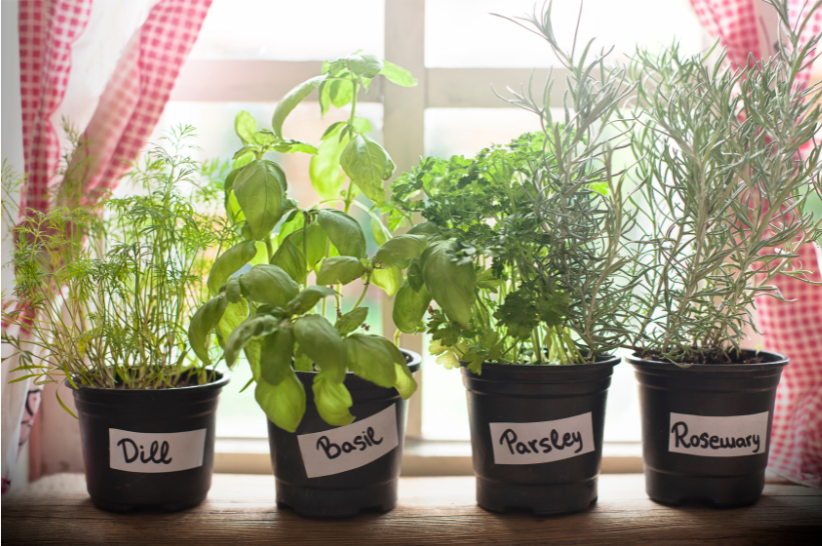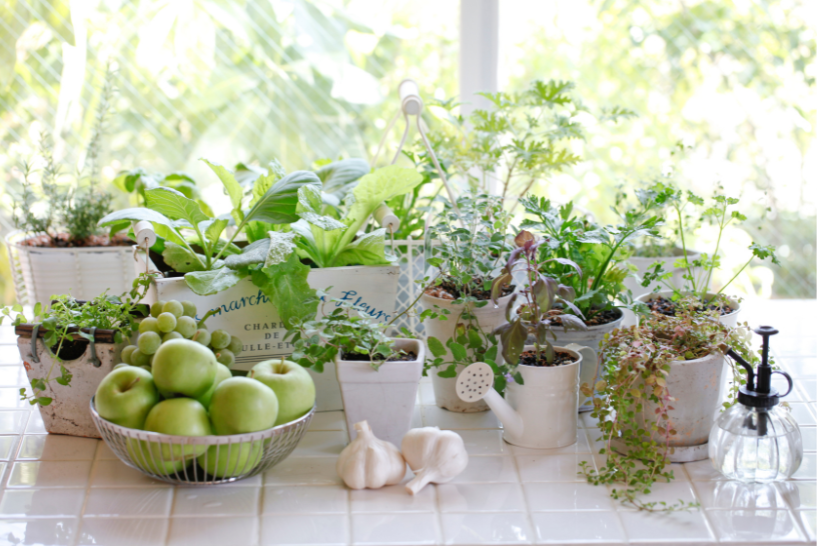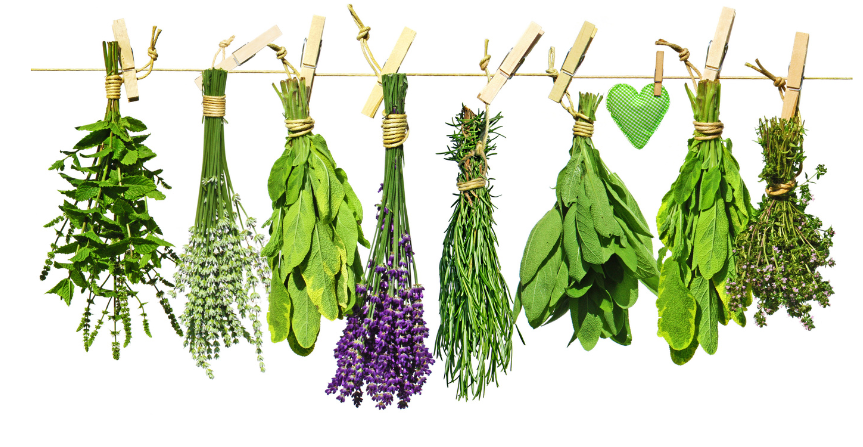(Even if You’ve Killed Every Houseplant Since 2009)
There’s a special kind of heartbreak that comes from paying $3.99 for grocery-store herbs, using two leaves, and finding the rest liquefied in the crisper a week later. The fix? Grow your own. Before you protest—I have no space, no time, no green thumb—hear me out. You don’t need a backyard, a sun-drenched greenhouse, or the patience of a Buddhist monk. A bright windowsill, a little water, and these five nearly bullet-proof herbs will have you snipping fresh flavor straight into dinner in no time.
We’re talking countertop convenience here—pots you can literally reach while the pasta’s boiling. And because we’re in Sacramento, our mild winters and gloriously long summers mean these herbs thrive year-round with minimal drama. Ready? Let’s dig in.
1. Basil: The Sunshine-Loving Pizza Perfector
Why basil makes the list
- Grows fast (gratification in weeks, not months)
- Pairs with almost everything: tomatoes, peaches, strawberries, even cocktails
- Smells like a mini trip to Italy every time you brush past it
Countertop survival tips
Light Basil wants 6–8 hours of direct sun. South- or west-facing window? Perfect. North window? Grab a cheap LED grow light—the clamp-on kind works.
Water Think “consistent moisture,” not swamp. If the top inch of soil feels dry, water until it seeps out the drainage hole.
Pinch, don’t pluck When stems hit 6 inches, pinch above a leaf node. This forces the plant to branch, giving you a bushier basil bush and delaying flowering (flowers = bitter leaves).
Use it tonight
Caprese isn’t a recipe; it’s a lifestyle. Layer garden-fresh basil with late-summer heirloom tomatoes from the Midtown Farmers Market, add a swipe of burrata, drizzle with local olive oil, and call it a Monday miracle.
2. Mint: The Over-Achiever You Can’t Actually Kill
Why mint makes the list
- Tolerates partial shade (hello, east-facing apartment!)
- Bounces back from neglect better than most relationships
- Turns everyday water into “spa water” and bourbon into a mint julep
Countertop survival tips
Contain it Mint’s roots spread like gossip. Keep it in its own pot so it doesn’t bully the basil.
Light Mint is chill—4–6 hours of indirect sun is enough.
Water Likes things a tad damper than basil; don’t let it bone-dry between drinks.
Haircut therapy Shear it by one-third every few weeks. This keeps flavor bright and prevents legginess.
Use it tonight
Muddle a handful of leaves with lime, top with sparkling water (or rum, no judgment), add a dash of Sacramento Honey’s wildflower honey, and sip on the patio while your neighbors water their lawn.
3. Chives: The Effortless Onion Upgrade
Why chives make the list
- Taste like mild green onions but take up less real estate
- Are perennial—plant once, harvest for years
- Purple pom-pom flowers double as edible garnish
Countertop survival tips
Light At least 4 hours of sun; they’re not sun divas but need decent light.
Water Moderate. Aim for evenly moist soil.
Haircut bonus Cut leaves 1 inch from soil level. They’ll regrow thicker in about a week.
Use it tonight
Sprinkle chopped chives over scrambled eggs, baked potatoes, or a bowl of ramen you’re pretending is homemade. The mild zing makes everything taste “chef-y” with almost zero effort.
4. Parsley: The Secret Workhorse (Not Just a Garnish, Karen)
Why parsley makes the list
- Provides vitamins A, C, and K in heroic doses
- Handles cooler temps, so winter kitchens are fine
- Fits Mediterranean, Mexican, Middle-Eastern, and BBQ dishes alike
Countertop survival tips
Flat-leaf vs curly Flat-leaf (Italian) equals stronger flavor and easier chopping. Curly is cute on deviled eggs. Your call.
Light 5–6 hours of sun; morning light is kinder in scorching Sacramento summers.
Water Keep soil slightly moist. Parsley wilts to tattle on you if you forget.
Harvest law Always cut the outer stems first; leave the inner “growing heart” intact for continuous regrowth.
Use it tonight
Toss a fistful of flat-leaf parsley with minced garlic, lemon zest, and olive oil for a lightning-fast gremolata that wakes up grilled salmon (or disguises Tuesday’s reheated chicken).

5. Thyme: The Tiny Powerhouse With Zero Drama
Why thyme makes the list
- Compact—perfect for jars, mugs, or that cute thrift-store teacup
- Drought tolerant (skip a watering, it forgives)
- Adds earthy aroma to everything from roasted veggies to cocktails
Countertop survival tips
Light Needs 6+ hours of direct sun. Loves that west-facing glare you thought was annoying.
Water Less is more. Soil should dry slightly between waterings.
Trim trick Snip entire 3-inch sprigs, not single leaves. This encourages bushiness.
Use it tonight
Infuse olive oil with thyme sprigs, drizzle over roasted farmers-market carrots, and crown with a few mint leaves. Fancy? Yes. Hard? Nope.
Setting Up Your Countertop Herb Bar (10-Minute Project)
- Pick pots with drainage. Root rot is real.
- Use high-quality potting mix—not garden soil, which compacts indoors.
- Line your splash zone. A simple tray catches rogue drips and makes you look organized.
- Group herbs by thirst. Basil + parsley (water lovers) on one end, thyme solo on the drier side.
- Label pots. Future you at 6 a.m. will forget what baby thyme looks like.
Light Hacks for Sun-Challenged Kitchens
- Clamp-on LED grow light ($20). Aim for 12–14-hour “daylight.”
- Aluminum-foil reflector behind the pots to bounce window light.
- Rotate pots 180° weekly so stems grow straight instead of reaching like drunk Jenga pieces.
Water & Feeding Cheat Sheet
| Herb | Water When… | Monthly Feeding? |
|---|---|---|
| Basil | Top inch dry | Half-strength all-purpose liquid |
| Mint | Top ½ inch dry | Rarely—mint’s a weed |
| Chives | Top inch dry | Sprinkle worm castings |
| Parsley | Top inch dry | Compost tea works great |
| Thyme | Top 2 inches dry | Skip—too much fertilizer kills flavor |
Rule of thumb: When in doubt, underwater—most herbs recover faster from drought than drowning.
Troubleshooting the Top 5 “Why Is My Herb Dying?” Crises
- Yellow leaves, soggy soil → You’re over-loving it. Let it dry.
- Leggy stems, pale color → Give it more light or prune harder.
- Brown crunchy tips → Under-watering or AC vent blast. Relocate or hydrate.
- White fuzzy stuff on soil → Fungal friends. Scrape top inch, improve airflow.
- Tiny flying gnats → Allow soil to dry longer; add sticky traps if they’re rude.
Harvest Without the Guilt: How Much Is Too Much?
- Basil & mint: Never strip more than ⅓ of the plant at once.
- Chives: Cut down to 1 inch above soil; they regrow swiftly.
- Parsley: Outer stems only, leave the crown.
- Thyme: Take whole sprigs, but keep at least half the greenery.
Think of harvesting like tipping at a restaurant—be generous, but don’t bankrupt the operation.

Zero-Waste Flavor Bombs: What to Do With Overflow
- Herb Ice Cubes — blitz leaves with olive oil, freeze in trays, pop into winter stews.
- Compound Butter — mash herbs into softened butter, roll, chill. Elevates Tuesday toast.
- Pesto Remix — basil with any nut or seed on hand; mint + pistachio = wow.
- Herb Salt — pulse dried thyme with coarse sea salt; sprinkle on fries.
- Infused Vinegar — parsley stems in apple-cider vinegar → instant salad pizzazz.
A Week of Countertop-Herb Dinners (Because Ideas > Theory)
| Day | Main Ingredient | Herb Hero | Quick How-To |
|---|---|---|---|
| Mon | Store-bought rotisserie chicken | Thyme | Warm with herb-infused oil |
| Tue | Boxed pasta | Basil | Classic pesto in blender |
| Wed | Farmers-market peaches | Mint | Dice fruit, add torn mint + feta |
| Thu | Omelet night | Chives | Fold in right before plating |
| Fri | Salmon fillets | Parsley | Flash-broil, top with gremolata |
| Sat | Tacos (anything) | Mixed bunch | Cilantro? Overrated—use basil + mint |
| Sun | Sheet-pan veggies | All the scraps | Roast, toss with herb butter |
Growing Herbs With Kids (or Easily Distracted Adults)
- Mint rooting experiment: Snip stem, stick in water. Roots in days = free plant + science lesson.
- “Name the basil” game: Kids water “Mr. Leafy” more reliably than they clean rooms.
- Taste tests: Blind-fold, compare store vs. home-grown. Home wins. Pride ensues.
Frequently Asked “Wait, Can I…?” Questions
Q: Can I propagate basil from grocery-store clamshells?
A: Totally. Snip 4-inch stems, strip lower leaves, pop in a glass of water. Roots appear in 7–10 days; plant in soil.
Q: Is tap water okay?
A: Sacramento’s water is generally herb-friendly. If leaves brown at tips, let water sit overnight to vent chlorine.
Q: Do I need fancy grow lights?
A: If your window gives 6 hours of direct sun, you’re fine. Otherwise a $20 LED strip beats spending $20 on wilted parsley bunches all year.
From Countertop to Community: Share the Herb Love
Overgrown mint? Basil forest? Bundle extras with twine, drop them on a neighbor’s porch. Post a “free fresh herbs” story on Instagram. Teach a friend your ice-cube pesto trick. The more you share, the more you’ll harvest—plants and goodwill alike.
Final Sprig of Wisdom
Growing herbs on your kitchen counter isn’t about becoming a homesteader. It’s about sprinkling a little fresh life into everyday meals—and proving to yourself that, yes, you can keep something green alive. Plus, every snip means one less sad plastic clamshell in the trash.
Start with one plant—basil if you crave caprese, mint if you survive on iced coffee. Then add another. Before long, you’ll have a tiny edible jungle cheering you on while you cook.
May your leaves stay lush, your waterings well-timed, and your pasta forever garnished. Happy countertop gardening, Sacramento!
Check out to design a home for entertaining guests here




